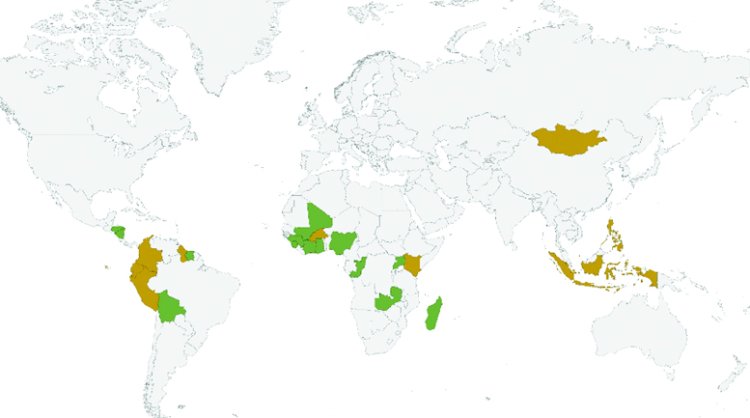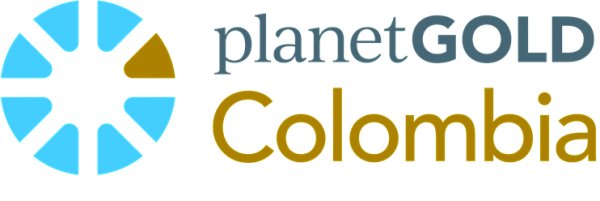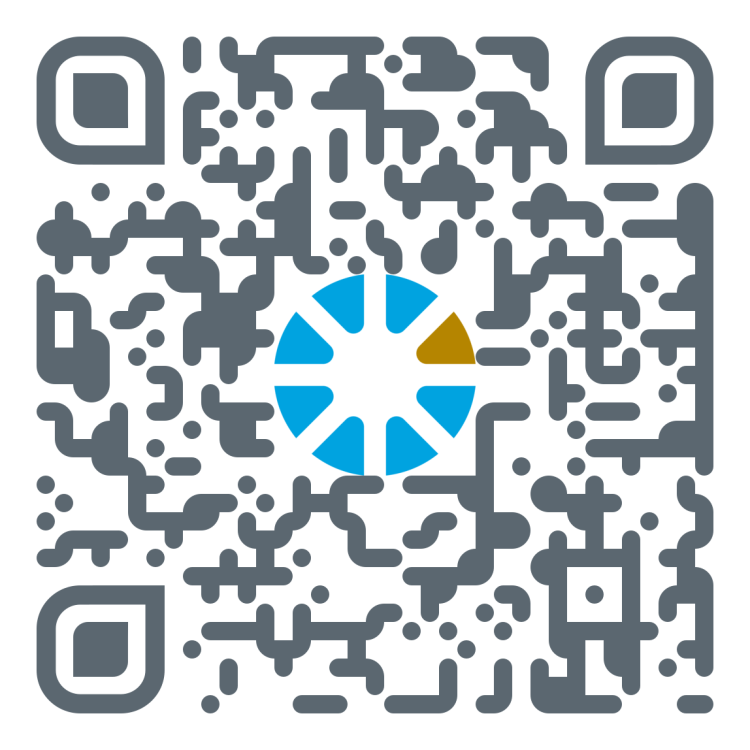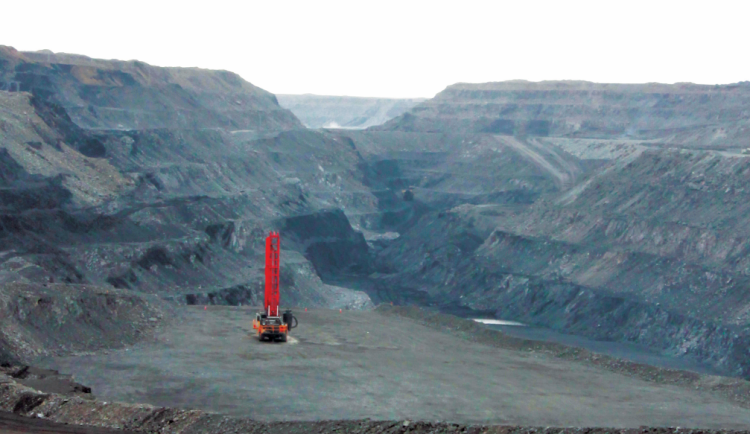M. DULGUUN, planetGOLD Mongolia Investment Specialist
“Hear from the one who has come back from a travel” is a Mongolian saying, meaning the one who has travelled brings many news and stories to share with their family, friends, and community. As for the ones eagerly waiting for the traveller to come back, they are excited and anticipate a fascinating fireside talk with the traveller to go through his/her days away from home and to imagine what they must have seen and experienced.
Through this blog, I wanted to share my experiences from the planetGOLD Global Forum, organized on June 3-6th, 2024 in Talisay, Batangas, Philippines. More specifically related to my job, I wanted to share my learning on enabling access to finance for artisanal and small-scale miners worldwide. I hope our readers can “hear us out” with an open mind and think of ways to improve the lives of artisanal and small-scale miners and reduce the gap to formal finance in this sector in Mongolia.
The planetGOLD programme works in partnership with governments, the private sector, and ASGM communities to significantly improve the production practices and work environment of artisanal and small-scale miners. By working to close the financing gap, supporting formalization, raising awareness, and connecting mining communities with mercury-free technologies and formal markets, the programme aims to demonstrate a pathway to cleaner and more efficient small-scale gold mining practices that benefit everyone, from mine to market.
Phase 1 of the planetGOLD programme is executed by government agencies and other organizations in Burkina Faso, Colombia, Ecuador, Guyana, Indonesia, Kenya, Mongolia, Peru, and the Philippines. Phase 2 includes countries such as Bolivia, Republic of Congo, Ghana, Honduras, Madagascar, Nigeria, Suriname, Uganda, Côte d’Ivoire, Guinea, Mali, Nicaragua, Sierra Leone, and Zambia, bringing the planetGOLD programme to a total of 23 countries.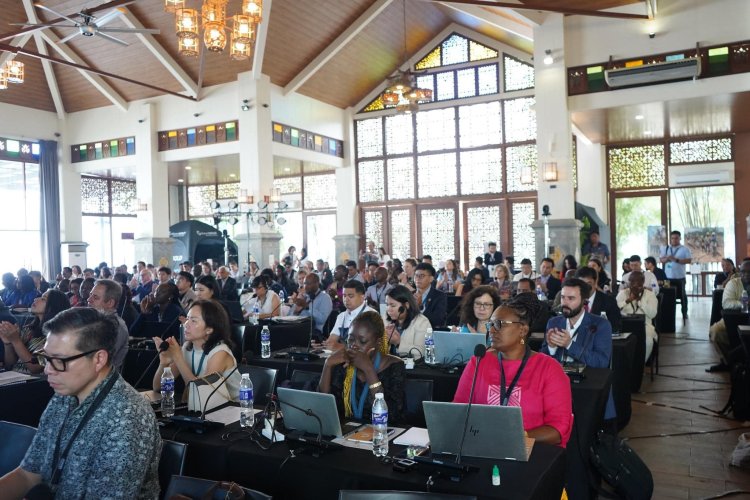 Over 200 participants attended the planetGOLD Global Forum, including government officials, international agencies, policy and technical specialists, miner representatives, and private-sector members.(Photo courtesy of planetGOLD Philippines, 2024)
Over 200 participants attended the planetGOLD Global Forum, including government officials, international agencies, policy and technical specialists, miner representatives, and private-sector members.(Photo courtesy of planetGOLD Philippines, 2024)
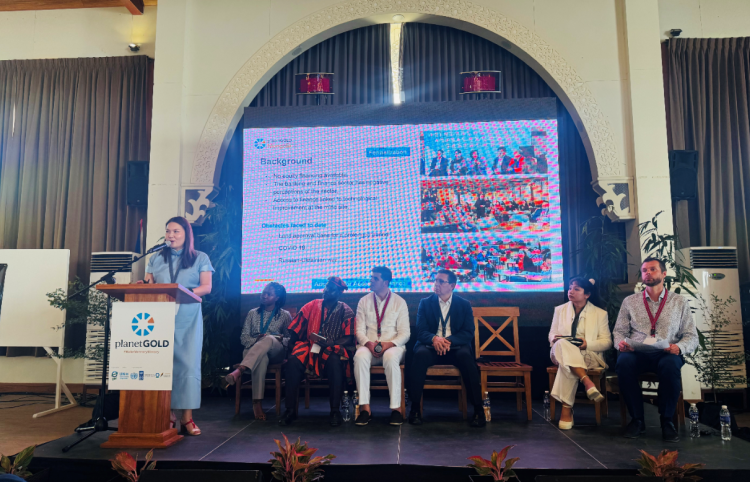 From left: Dulguun Mijiddorj, planetGOLD Mongolia Investment Specialist; other speakers on the Solutions Lab session on the Global Forum
From left: Dulguun Mijiddorj, planetGOLD Mongolia Investment Specialist; other speakers on the Solutions Lab session on the Global Forum
The knowledge sharing event, planetGOLD Global Forum 2024, organized by the GEF-funded planetGOLD programme, aimed to bring together a wide range of stakeholders-including miner representatives, government officials, international agencies, policy and technical experts, and members of the private sector-to share ideas and lessons learned in their efforts to improve and professionalize the ASGM sector, and to work together towards a mercury-free future.
Over three days, sessions explored some of the most critical issues in the ASGM sector, including technologies for mercury-free gold processing, opportunities to improve financial access for the sector, strategies to protect vulnerable people, taxation policies, and more1.
The first day started with a panel discussing the experiences and lessons learned from phase 1 planetGOLD countries, such as Mongolia, the Philippines, Burkina Faso, Colombia, and Ecuador. We ask you, dear reader, to consider how certain examples and initiatives from different countries can be “cultivated in Mongolian soil.”
Colombia – Guarantee fund
In Colombia, access to microfinance is limited to most small and medium enterprises (SMEs), and miners need help accessing formal financial options, similar to our conditions in Mongolia. To address this, planetGOLD Colombia established a guarantee fund of USD 66,000 for the bank which helped reduce the risk of lending to miners. The risk associated with artisanal mining is very high across the world. Mongolia is not the exception. When the project team met with the commercial banks and financial institutions back in 2019-2020, one of the main reasons for disregarding the sector was the perception of the high risk of ASGM lending because of the lack of formalization, and overall negative opinion from the public on ASGM activities.
With the support of the planetGOLD team, the bank benefitted from training helping them to contextualize the sector and assess debt mechanisms designed to suit the miners' needs and encourage their participation. Contextualizing the activity is very important when designing lending mechanisms. For instance, in the case of Mongolia, if a miner were to get a loan for his/her operation, the loan payback would have to consider the seasonality of the mining operations. Miners might not be able to provide payment stably every month, even though hard rock mining could be done throughout the year, for placer mining that is not the case. Placer mining is active only during warmer months. Also, if the miners have other alternative businesses, such as agriculture or livestock herding, they might need additional time off the mining operations. Thus, the financial institution will need to take into consideration the peculiarities of the sector.
In the case of Colombia, the bank can only offer an annual interest rate of 16%-20% to regular small and medium enterprises. However, due to the higher risk involved, artisanal miners are offered a higher interest rate of 30%-35%. This differentiation is justified by the banks because of their perception of the risks associated with ASGM activities. Note that a component of the risks is due to the lack of information and knowledge from the financial institutions, and their risk-averse attitudes resulting in a lack of experience lending to mining activities. On the other hand, the risk is not due to the “mining activity” per se, but mostly caused by the regulatory uncertainty in which they operate, and to fluctuations in key variables such as the dollar, price of gold, unreliability of supply, etc.
However, thanks to the efforts of the planetGOLD program the bank has not only been able to create a revolving fund mechanism through the guarantee fund, but it also supports miners in their loan applications and trusts in their ability to know the suitable investment needs to improve their operational efficiency.
The bank and the project team are still refining the model based on the lessons learned. Key learnings include exploring the feasibility of providing higher credit amounts to first-time applicants due to the high demand.
However, at the end of a successful initiative by a development organization, there needs to be consideration about sustainability and continuation or escalation of the same model into a bigger and more localized effort. Often, these initiatives are started with an international donor and the government, which in turn sparks the question of whether the ASGM sector can attract the interest of private lending institutions to bring more sustainability even after the project.
Burkina Faso - Revolving fund
The objective of the financial mechanism in Burkina Faso is to provide accessible financial resources for ASGM to purchase equipment, tools, or other basic needs to enable more environmentally friendlier, socially responsible, and efficient operations.
It is a revolving fund administered by a local experienced bank (Coris Bank International), leveraging a seed capital grant from the planetGOLD Burkina Faso, in the amount of USD 50,000. According to the team, placing the fund in an experienced bank guarantees efficient operation and good governance of such a financial instrument.
The bank charges an interest rate of 8% per year, lower than its standard market rate of 10% because the fund meets the government's criteria for a green climate fund. Each party bears 1/3 of the risk: the fund, the mining cooperative, and the bank. However, the bank asks for mortgage guarantees from miners which is something the project is working to convince the bank to modify. First, requiring a mortgage as a guarantee makes the lending too restrictive, particularly for women miners.
The fund started with a seed capital from the planetGOLD, but it is actively requesting support from large-scale mining companies, and artisanal mining organizations. The fund's operational team consists of the mining cooperative, the project, the government, and the focal point.
When the fund started, seven mining cooperatives applied for loans, and three were approved. The project assisted the miners in their formalization process and in setting up a cooperative. It also supported them with the loan application, which requires the development of a business plan. The management committee reviewed the application and sent it to the bank with their observations for a final decision.
The process is as follows: Once the project team has completed helping the mining cooperative with their application, the bank's internal committee assesses and decides which cooperatives can borrow from the fund. If the application is approved, the bank will send a notification to the cooperative. The project team also assists in ensuring the proper distribution of the funds.
Mongolia - Savings and Credit Cooperative
Back in 2019 at the start of the project, the project team researched the legal environment governing the artisanal mining sector in Mongolia. The equity financing model was not possible according to the regulations. Moreover, the main ASM regulations were suspended until 2022. For that reason, the project decided to focus on building knowledge and capacity about the sector to financial and investment stakeholders. The project team organized several meetings, conferences, and forums with the participation of key representatives from the government, financial institutions, and banks. The overall objective was to highlight the importance of formalizing miners and providing access to funding. 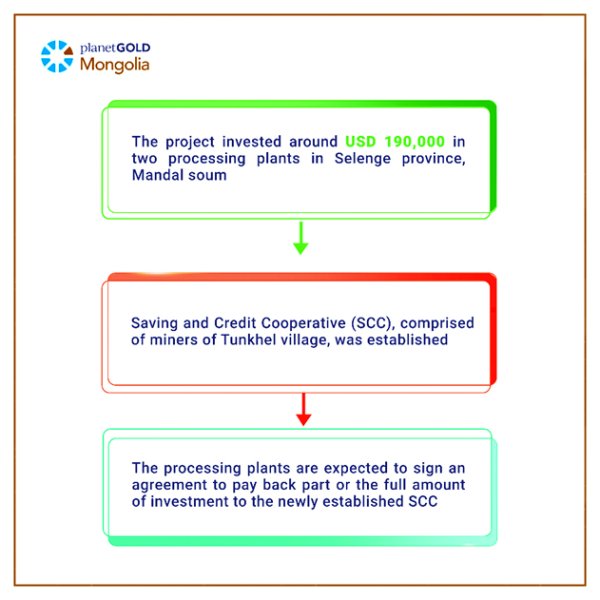 Through its technical improvement component, the project invested around USD 190,000 in two processing plants in Selenge province, Mandal soum. The selection of these plants was based on a careful site selection criteria process, which has become a key requirement by the executing agency (AGC) when executing new projects. The processing plants are expected to sign an agreement to pay back part or the full amount of investment to the newly established Saving and Credit Cooperative, comprised of miners of the same area. The cooperative will run a loan fund that will disburse small loans for responsible mining. Currently, the new cooperative has been established, and the special license has been acquired to run as a savings and loan cooperative. The agreement to be signed with the processing plants is drafted and the negotiations with the processing plants have started. Even though the cooperative is starting with 20 miners, to ease the starting phase, it can potentially increase to all 400 miners in the area.
Through its technical improvement component, the project invested around USD 190,000 in two processing plants in Selenge province, Mandal soum. The selection of these plants was based on a careful site selection criteria process, which has become a key requirement by the executing agency (AGC) when executing new projects. The processing plants are expected to sign an agreement to pay back part or the full amount of investment to the newly established Saving and Credit Cooperative, comprised of miners of the same area. The cooperative will run a loan fund that will disburse small loans for responsible mining. Currently, the new cooperative has been established, and the special license has been acquired to run as a savings and loan cooperative. The agreement to be signed with the processing plants is drafted and the negotiations with the processing plants have started. Even though the cooperative is starting with 20 miners, to ease the starting phase, it can potentially increase to all 400 miners in the area.
This idea could also be replicated by the government or the Central Bank. The Bank would offer MFPS technology at subsidized prices, which the miners would then purchase and use the proceeds of the payments to create a fund for microlending.
planetGOLD Mongolia has been the pioneer in promoting the idea of providing access to finance for artisanal and small-scale miners in Mongolia, where they were deemed to be informal and illegal.
Ecuador - Interinstitutional Agreement through the Gold Acquisition Program 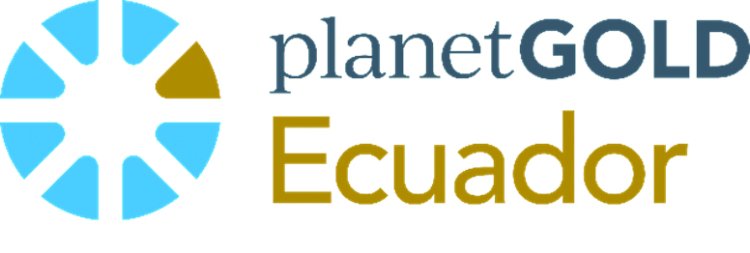
Similar to the Bank of Mongolia, the Central Bank of Ecuador (CBE) buys gold from artisanal miners directly or indirectly through authorized gold traders. Some of the objectives of their gold-buying program are i) to improve the formalization of miners and ii) to provide them access to sources of finance. The main requirements of the gold-buying program of the CBE are:
- Work only with formalized miners;
- Miners should be using environmentally friendly processing techniques;
- Due diligence process ensured.
Currently, two CBE branches buy gold, and another one is expected to open in 2025, to be located in an area with an active number of artisanal mines, reducing transportation costs for miners.
The main actors of the Interinstitutional agreement that aims to improve financial conditions and environmental practices of miners are the CBE, Ministry of Energy and Mines, Ministry of Environment, and BanEcuador- a State-owned Commercial Bank. This agreement allows authorized small-scale miners that sell gold to the CBE to have access to loans under competitive financial conditions via BanEcuador, while ensuring implementation of best environmental practices promoted by the Ministry of Environment. Currently, there are two certified miners who have accessed the loan of USD 170,000 in total. An additional 21 agents have started their application for credit with this program. Because BanEcuador is a state-owned bank, this brings us back to our discussion about increasing involvement from the private sector to ensure sustainability for all countries with ASGM funding projects.
Philippines - Supplier agreement
Similar to Mongolia and Ecuador, the Central Bank of the Philippines is the primary organization in charge of purchasing gold produced in the Philippines. The Supplier agreement presented during the forum is a document that aims to solidify the gold buying and selling relationship between the Central Bank and the partner mining associations. It is also intended to be a supporting document (“proof of income”) for mining associations’ loan applications.
The planetGOLD criteria2 will be used to enhance the due diligence of the process.
The supplier agreement is currently under revision by the Central Bank of the Philippines’ legal team. It will substitute the gold trader application process of the Central Bank, which includes tedious and often expensive requirements.
The agreement adds an element of development by bringing in a dual purpose by acting as collateral for mining organizations seeking access to loans from formal financial institutions. Additionally, the generated CRAFT Code pG Version reports shall be presented as one of the supporting documents of the mining organizations to prove their creditworthiness. Where there was previously only a “customer” relationship between the Central Bank and the small-scale gold miner, the agreement opens another door for cooperation between the government and the ASGM sector.
Other initiatives
During the Global Forum, other non-planetGOLD initiatives, ideas, and experiences were presented. Below, I am sharing an example from two organizations working with artisanal and small-scale miners from Congo, Tanzania, and Kenya.
Trust Merchant Bank (TMB) - Democratic Republic of Congo (DRC)
Trust Merchant Bank (TMB) is a commercial financial institution in the DRC. It aims to become a universal bank and sees the ASM sector as a significant economic opportunity, with over 1 million people directly involved. The bank has a seven-year plan to demonstrate the feasibility of its engagement with the sector. TMB believes it can contribute to the formalization and professionalization of the sector, improving ESG standards, and demonstrating the viability of ASM banking in the DRC.
The bank has established a risk rating system for its clients, including the newly onboarded ASM clientele. Miners' risk ratings determine their financing options, with higher ratings resulting in better financing options.
Miners undergo an annual assessment to monitor their progress to the risk rating. They are also provided with support to help them improve their rating. Despite the risks, the bank offers ASM clients the same interest rate as other productive sectors, such as agriculture. To enhance miners' access to its services, the bank is promoting using its mobile platform, People Mobile, which is designed to be more accessible to miners in rural areas. This will allow the bank to monitor their financial activities and determine the amount of credit that can be extended to them.
Currently, the bank serves 30 ASM clients and has 39 potential new ones, who are organized into legal entities, such as cooperatives, as required by national laws.
The bank had a great idea to propose to artisanal miners, continuing the topic of catering to the specific needs of ASGM-ers. The bank is considering the concept of a “Negative interest rate”. If there were grant funding available, instead of providing mining equipment for free to miners seeking to professionalize their operations, it may be more effective to offer a negative interest rate. This means leasing the equipment to miners, allowing them to build a repayment history. Miners are required to repay only a portion of the loan within a specified timeframe at 0% interest. If they meet the repayment terms, the lease agreement is terminated, and the remainder of the payment is given as a grant. This is another good idea to have a loan product specific to artisanal miners.
The Impact Facility (TIF) – Kenya and Tanzania
The Impact Facility for Sustainable Mineral Communities (TIF) utilizes a blended-financing model, using grant financing to provide capacity support in various areas to miners, such as mercury management, operational health and safety (OHS), financial management, and equipment technical support. Additionally, impact investment funds are used to offer new mining equipment to miners at a commercial interest rate.
The Impact Facility decided to provide equipment through a lease model rather than a loan model to ensure that the equipment remains under TIF's ownership, eliminating the need for collateral from miners.
Let me explain this program, my reader. After going through the application process for an equipment lease, upon approval, TIF presents a draft lease-to-purchase agreement to the ASM organization, and it's given a period of up to 12 weeks to provide a security deposit amounting to 10% of the landed cost of the equipment for the deal to be finalized. The contract terms include:
- Payment methods accepted: bank transfers or mobile banking
- Optional: a grace period of up to 2 months
- Optional: two complimentary annual payment breaks (considering factors like mine site flooding, shaft development, or other delays affecting mine production and revenue) with a 24-hour prior notice and two paid payment breaks per year, subject to TIF's discretion, after exhausting the free options at a cost of $60 each
- Penalties for delayed or missed payments: KES 1,000 (around $7) per day after the monthly repayment deadline (5th of the month) until the 20th of the month, after which the mine will be deemed in breach of the contract
- In case of default, if TIF and the lessee cannot resolve the issue, TIF will request the return of the equipment and endeavour to redeploy it through a new lease-to-purchase agreement promptly.
- TIF facilitates servicing and maintenance in line with the terms of the specific lease agreement.
- At the end of the lease period, the ASGM operator has the option to acquire ownership of the equipment for a nominal fee of KES 100 ($0.75).
TIF aims to enhance the sector's professionalism and best mining practices of ASGM , transitioning them to small-scale operations since they believe these type of operations are more mechanized, safer, and environmentally responsible. By the end of 2026, TIF targets to reach 40 mines and 3,000 miners in Tanzania and Kenya, to boost gold production by a minimum of 25kg/year (approximately $1.5m/year) and promote better ESG performance, particularly in areas like mercury reduction.
My conclusion for you reader…
The financial mechanisms mentioned here all have their benefits and their limitations, all share some similarities but also are adapted to the local conditions they operate. For example, the organization responsible for disbursing and managing the loan fund is sometimes the Central Bank itself, but in other cases commercial banks or a small financial institution. In many countries, the government and the planetGOLD project have combined their efforts to ensure financial support in the ASGM sector. In some countries, the bank itself, TMB, or another international initiative, such as TIF, have taken matters of drawing finance into ASGM into their own hands. Almost every country mentioned on the forum has started its operation by spreading knowledge and information to the financial sector representatives to help them understand that the sector is worth looking into as a client for a separate loan product. All the participants mentioned the significant time and duration spent in negotiations and subtle convincing. Although some planetGOLD countries have already launched their initiatives and some are only starting, it is evident that the processes need substantial cooperation and partnership between all the stakeholders involved, such as the government, banking and financial institutions, the miners, and the projects, for long-term success and sustainability. This can also be seen from the already established operations of TMB and The Impact Facility. Despite the fact that almost all countries mentioned the same issues and obstacles that this sector faces when trying to obtain loans and funding, they all thrived and found ways to improve access to finance in their own individual countries.
Thus, we hope this blog can serve its aim of planting a seed for thought on providing better and improved conditions for thousands of miners in Mongolia and all around the world, which is the very essence of the phrase we started this blog “Hear the one who has travelled”, so that we could learn from them.
For regular project updates, follow us on Facebook.



